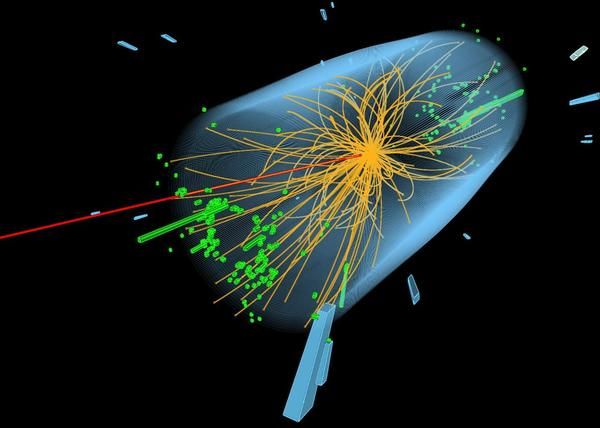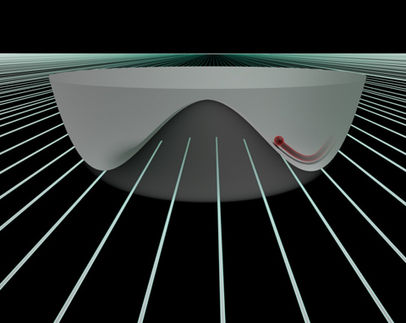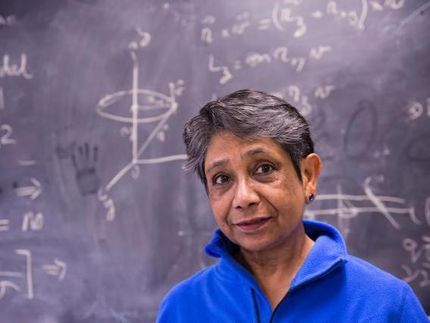Getting to Know the Higgs Boson
CMS experiment confirms predicted Higgs boson decay into leptons
Advertisement
Researchers of the international CMS collaboration have found the first experimental evidence for the decay of the recently discovered Higgs boson into a pair of tau leptons. Leptons are a class of elementary particles whose most prominent member is the electron. The study, which used data from the world’s largest particle accelerator LHC (Large Hadron Collider, CERN, Switzerland), validates earlier theoretical predictions of the Higgs boson’s properties. The team, which also comprises DESY scientists, reported its results in the Journal of High Energy Physics.

Collision event recorded with the CMS detector at the LHC (CERN, Switzerland). The event contains a candidate for a Higgs boson decay into a pair of tau leptons. Like Higgs bosons, tau leptons are too short-lived to be detected directly and their production is inferred from the decay products. One of the tau leptons decays into another set of leptons: a muon, represented by the red line extending to the left, and two undetectable neutrinos. The other tau particle decays into hadrons, shown as the two large blue towers at the bottom.
CERN
In 2012, the LHC experiments CMS and ATLAS announced the discovery of a new fundamental particle, which turned out to be the long sought-after Higgs boson. As the key to why elementary particles have specific masses, it was the last missing piece of the Standard Model – the current gold standard for the theoretical description of the properties of all known particles and their interactions.
“The discovery was a big milestone for physics,” says Rainer Mankel, staff scientist in DESY’s CMS group and co-author of the new study. “Yet, we are continuing to analyze the Higgs boson’s properties in detail in order to find out if they match our theoretical expectations.”
One way of doing so is to measure its decays into other fundamental particles as predicted by the Standard Model. The initial CMS and ATLAS analyses concentrated on decays into particles known as gauge bosons – the carrier particles of the fundamental forces. “These decays have clear signatures,” says Mankel. “They stick out of the background and are rather easy to identify.”
Other predicted decays, such as into leptons, are more challenging to observe because they are obscured by an overwhelming background signal. Nevertheless, researchers must measure them in order to fully characterize the newly found Higgs boson. “If we didn’t observe these decays, we would know that something does not match up with our theoretical tools,” explains co-author Alexei Raspereza from DESY’s CMS group.
Higgs Boson Decay into Tau Leptons
In the recent study, the CMS researchers were now able to confirm for the first time that the Higgs boson does indeed decay into leptons. By analyzing data of the 2011 and 2012 runs of LHC, which produces Higgs bosons in powerful proton-proton collisions, the team determined that a fraction of the short-lived Higgs particles decayed into pairs of tau leptons – particles that have similar properties as electrons but are almost 3,500 times as heavy. The results were independently confirmed by the ATLAS experiment.
“Our result is a crucial validation of the Standard Model,” Raspereza points out. “It proves experimentally that the Higgs particle not only decays into bosons as previously observed but also into fermions.” Physicists categorize particles as either fermions, which include leptons, or bosons, depending on their spin.
For their study, the CMS team had to overcome a series of challenges. First, they developed elaborate methods to properly distinguish signal from background processes. Moreover, tau leptons are too short-lived to be detected directly and decay in many ways. To further complicate things, the Higgs boson can be produced in various processes, demanding that the researchers include a multitude of different production and decay paths in a difficult analysis. Finally, the large number of LHC collision events itself posed a challenge. In 2011 and 2012 combined, the CMS detector recorded almost ten billion events but only a minuscule fraction is due to Higgs boson decays into tau leptons. Therefore, the scientists had to develop criteria to efficiently select the few hundred events used in the analysis.
Search for New Physics
The CMS studies of Higgs boson decays into fermions serve a greater purpose than merely confirming the current theoretical gold standard. They may also hint at new phenomena. “Nature is richer than our imagination, and there are theories that extend the Standard Model,” says Raspereza. A theoretical concept called supersymmetry, for instance, proposes that every elementary particle of the Standard Model has a superpartner. Some of these hypothetical particles could potentially help explain why only an estimated five percent of the universe is composed of known particles while the rest is filled with mysterious dark matter and dark energy whose nature is unknown to man.
Supersymmetry predicts that the recently discovered Higgs particle is actually only one of several Higgs bosons. Additional Higgs bosons would then manifest themselves in events involving, for example, three bottom quarks. Quarks and leptons are the elementary fermions. “At CMS, we developed criteria to specifically select these proposed event signatures already during data collection,” Mankel says. “This puts us in a unique position to search for additional Higgs bosons and new physics beyond the Standard Model.”
As of now, the CMS team has not found any supersymmetric particles, but the search is only in the beginning stages. “Supersymmetry is a theory with many unknown parameters,” says Raspereza. “The results obtained so far establish constraints on these parameters, narrowing our search and guiding the development of future models.”


































































